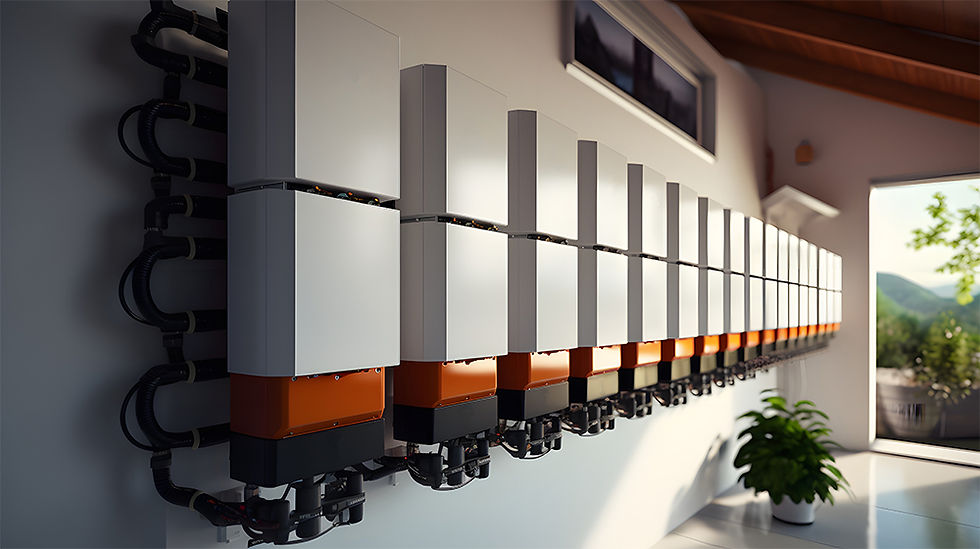Connecting Lead Acid Batteries: Various Configurations and Their Applications
- Jonny Appleton
.png/v1/fill/w_320,h_320/file.jpg)
- Oct 20, 2023
- 3 min read
Updated: Oct 23, 2023
Lead acid batteries have been a trusted power source for over a century, offering reliability and affordability for a wide range of applications.
These batteries are commonly used in vehicles, backup power systems, and renewable energy setups. Connecting lead acid batteries in different configurations can significantly impact their performance and applications. Once connected in the correct configuration, monitoring is the next step in ensuring good performance and longevity of your lead acid batteries - find out how enee.io provides this here. We will look at the various ways to connect lead acid batteries and discuss their practical uses.

Series Connection
Connecting lead acid batteries in series involves connecting the positive terminal of one battery to the negative terminal of another. This increases the overall voltage while keeping the capacity (ampere-hours) constant. For instance, if you connect two 12V lead acid batteries in series, you will get a 24V battery system.
Applications:
Electric vehicles: Connecting lead acid batteries in series are used in electric cars and scooters to achieve the desired voltage level.
Off-grid solar systems: It's common to connect multiple 12V batteries in series to create higher voltage arrays, suitable for inverter systems.
Parallel Connection
Connecting lead acid batteries in parallel is made by connecting the positive terminals of multiple batteries together and the negative terminals together. This setup increases the overall capacity while keeping the voltage constant. If you connect two 12V lead acid batteries in parallel, you will have a 12V battery with double the capacity.
Applications:
Backup power systems: Connecting lead acid batteries in parallel are often used in uninterruptible power supplies (UPS) to extend the runtime during power outages.
Recreational vehicles (RVs): Parallel connections can provide longer-lasting power for appliances and lighting in RVs.
Series-Parallel Combination
This configuration combines connecting lead acid batteries in both series and parallel. It is achieved by connecting a series of lead acid batteries in parallel, or vice versa. For example, you can connect two sets of 12V batteries in series and then connect those sets in parallel.
Applications:
Grid-tied solar systems: Series-parallel combinations help balance voltage and capacity to match the requirements of the inverter.
Forklifts: Forklifts often use this setup to optimize power and runtime.
Find out more here.
Dual Voltage Systems
Dual voltage systems utilize two sets of lead acid batteries, typically a higher voltage set and a lower voltage set, connected in parallel. This arrangement allows for the use of the higher voltage set for the primary power source and the lower voltage set for auxiliary power, creating redundancy.
Applications:
Emergency lighting: A dual voltage system ensures that emergency lighting remains functional in case the primary power source fails.
Telecommunications: This setup is common in remote cell towers to provide a backup power supply.
Hybrid Connection
Hybrid connections involve combining lead acid batteries with other battery technologies like lithium-ion. This allows for the benefits of both technologies, such as the high energy density of lithium-ion batteries and the cost-effectiveness of lead acid batteries.
Applications:
Hybrid electric vehicles: Combining lead acid batteries with lithium-ion batteries can enhance the energy storage capacity and reduce costs.
Renewable energy storage: This configuration can provide an efficient and cost-effective solution for storing excess energy from solar or wind sources.
Series Connection with Equalization
In series connections, it's crucial to perform periodic equalization to ensure that each battery in the series is charged and discharged evenly. Equalization involves applying a higher voltage charge to the entire battery bank. This process helps prevent the weaker batteries from becoming overcharged or undercharged, which can lead to a reduced lifespan.
Applications:
Large-scale off-grid systems: Equalization is essential in systems that rely on multiple series-connected batteries, such as those in remote areas or off-grid communities.
Find out more here.
Isolation Switches and Disconnects
When connecting lead acid batteries for specific applications, it's often important to incorporate isolation switches or disconnects. These switches allow you to isolate individual batteries or battery banks for maintenance, safety, or system expansion.
Applications:
Emergency power systems: Isolation switches are critical for isolating faulty battery banks and replacing them without interrupting power supply.
Marine and RV setups: Switches are used to manage power distribution and isolate batteries when not in use.
Conclusion
Lead acid batteries remain a reliable and versatile energy storage option for a variety of applications. The way you connect these batteries can greatly impact their performance and effectiveness in your specific use case. Whether you're looking to increase voltage, capacity, or both, understanding the different configurations and their applications is essential to making informed choices for your energy needs. From connecting lead acid batteries in series and parallel, to hybrid systems and equalization techniques, lead acid batteries offer flexibility and practicality in a world with diverse power requirements. Once the correct configuration has been implemented it is important to continuously monitor the performance and health of the batteries in that application.
Through plug-and-play sensors and a mobile app, enee.io provides the information you need to optimize energy usage, improve energy system health and safeguard backup power. Get in touch today to learn more.